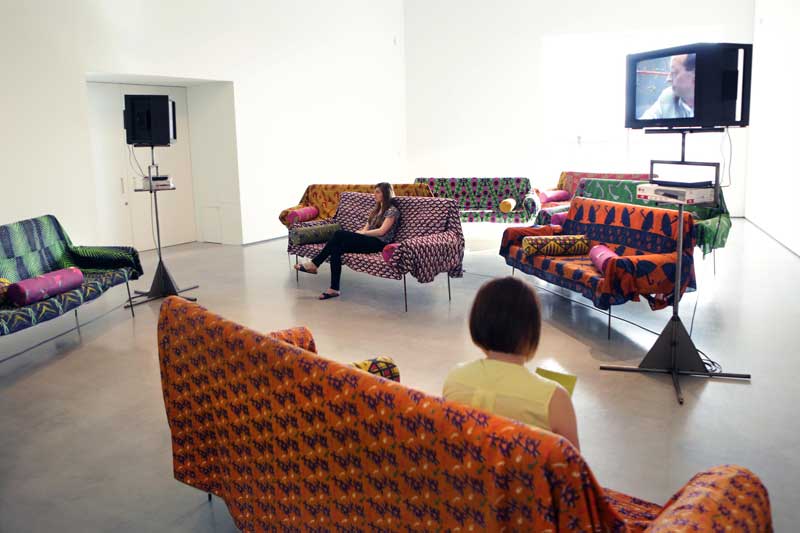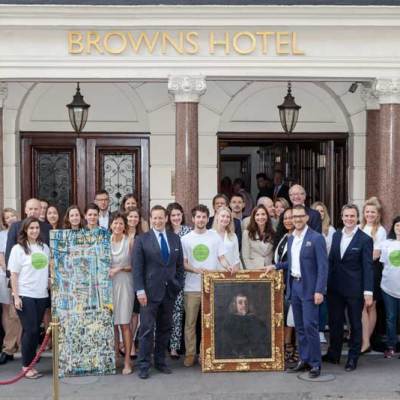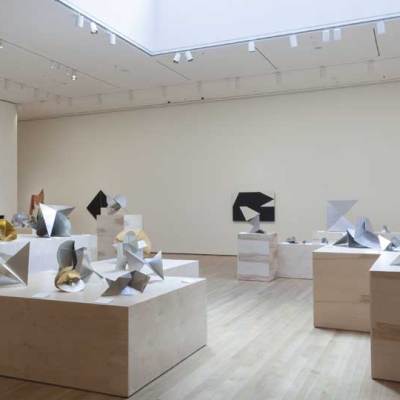As you turn the corner of David Chipperfield’s elegant series of dove grey concrete cuboids, The Hepworth Wakefield, to climb the stairs to the gallery’s entrance, an enormous white plaster nose stands ahead of you. It is outrageous in its eyelessness. It thrusts into the air, without logic or elegance; with just an appalled ‘O’ for a mouth. It seems all at odds with the classical serenity of Barbara Hepworth’s sculpture.
Lemur Head (2001), Franz West. Galerie Meyer Kainter, Vienna. Photo © Gabriel Szabo / Guzelian and the legal successors of Franz West. Installation image courtesy The Hepworth Wakefield

This cartoon head is Lemurenheim (‘Lemur Head’, 2002), a work in plaster made by the Austrian artist Franz West in collaboration with the artist Rudolf Stingel in response to an invitation by the architect Hermann Czech to create a series of sculptures for a bridge in Vienna. At the time of the commission, West was drinking heavily (it was alcoholism that would ultimately precipitate his early death in 2013, aged just 66), and a common Viennese phrase to capture the sensation of waking up with a hangover is ‘seeing lemuren’ or ‘zombies’. West played with the idea of these zombies rising out of the river.
In addition, the word ‘lemur’ is sometimes used to designate the ancient middle-class ladies who haunt Viennese coffee shops. This assertively sculptural, hand-made object is thus the progeny of a multiple play on words. It is also an emblem of the human condition, as well as a joke on our human habit of projection, whereby every large circular object with a hole in it becomes a head, capable of tragedy. Thus those two Viennese titans of modern thought, Freud and Wittgenstein, through the ideas of psychoanalysis and language games, can be seen both to have their share in this comic monster.
Fred Jellinek with Adaptives (1974) Photo © Friedl Kubelka, Archive Franz West / legal successors of France West

Standing beside the river Calder, with its own ghosts, this head is as good a summary of West’s work as one could hope to find. It draws deeply on his intellectual heroes while exuberantly bringing something entirely new into existence. It refuses any one description or explanation but most certainly requires a response. Most fittingly of all, while it is itself the result of a collaboration with one artist, the sculpture also points ahead to the show inside, which reveals unexpected parallels between Vienna’s star artist and Wakefield’s own Hepworth.
Das Geraune (Murmering) (1998), Franz West. Private collection, Austria © Gabriel Szabo / Guzelian and the legal successors of Franz West. Installation image courtesy The Hepworth Wakefield.

The show ‘Where is My Eight’ was initiated by West in 2012 for mumok, (Museum Moderner Kunst Stiftung Ludwig Wien), in Vienna, where West lived, with the show’s title a play on that of an earlier work. The show encompasses work from his famous Passstücke (or ‘Adaptives’, from the 1970s – bizarre shapes and objects made from plaster and metal which invite the audience to pick them up and interact), through his beguiling Das Geraune (‘Murmuring’, 1988), a collection of three giant papier-mâché forms with holes for mouths, to the enormous outdoor sculptures in aluminium and epoxy resin he conceived from 1996. Also part of the show is the tremendous Parrhesia (‘Freedom of Speech’, 2010), a collection of seven roughly painted papier-mâché head-like forms mounted with spikes on plinths, a haunting reminder of our democratic duty to speak out the truth, as we see it.
Parrhesia (2010), Franz West. Installation view, ‘Franz West: Where is my Eight?’ at The Hepworth Wakefield 2014. Louisiana Museum of Modern Art, Humlebaek. Photo © Gabriel Szabo/Guzelian and the legal successors of Franz West

In 2013, however, the artist died, leaving the curator Eva Badura-Triska, a longtime friend and admirer, to complete the project in West’s spirit. Inevitably, this show has become both retrospective and memorial. As Badura-Triska explained to the assembled press in Wakefield, reconciling these two ambitions is an almost impossible task, given that part of West’s way of working was always to improvise, expanding the possible range of meanings of old works by mixing them up again in new contexts. How do you honour a champion of irreverence or enable the audience to experience work as provisional, essentially undogmatic, even though it will now for ever be unchanging?
Ordinary Language (1993/95), Franz West. Herbert Foundation, Ghent © Gabriel Szabo / Guzelian and the legal successors of Franz West. Installation image courtesy The Hepworth Wakefield

The first room offers a taste of permanent instability. Ordinary Language (1995) is a crowded collection of simple metal frame sofas, covered with an array of patterned cotton fabrics, in a kind of shorthand for the psychoanalytic couch. You can hold a conference here or chat to a friend; you can fall asleep or watch two videos transmitting The Ordered Oval (1992/3), a film by West and others featuring conversations between people in the art world. Or you can stare at Personale (1995/7), a rectangular presentation of several different paintings, prints and drawings by friends and peers of West – including Martin Kippenberger and Heimo Zobernig.
If this spirit of freedom is one theme to emerge strongly, another is the importance of objects, especially hand-made objects. And it is here that West’s affinity with Hepworth is clearest: in their shared commitment to making and the transformation of brute material into something meaningful, however ambiguous or elusive that meaning, however much it might slip away back into the river like the ghost of a thought.
‘Franz West: Where is My Eight?’ is at the Hepworth Wakefield until 14 September.



